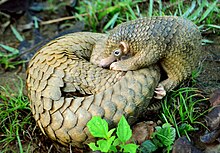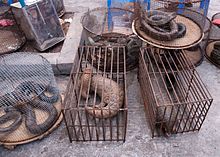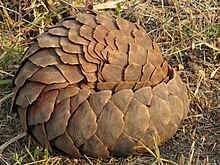Pangolins have large, protective keratin scales covering their skin; they are the only known mammals with this feature. They live in hollow trees or burrows, depending on the species. Pangolins are nocturnal, and their diet consists of mainly ants and termites, which they capture using their long tongues. They tend to be solitary animals, meeting only to mate and produce a litter of one to three offspring, which are raised for about two years.
Pangolins are threatened by poaching (for their meat and scales) and heavy deforestation of their natural habitats, and are the most trafficked mammals in the world.[4] Of the eight species of pangolin, four (Phataginus tetradactyla, P. tricuspis, Smutsia gigantea, and S. temminckii) are listed as vulnerable, two (Manis crassicaudata and M. culionensis) are listed as endangered, and two (M. pentadactyla and M. javanica) are listed as critically endangered on the International Union for Conservation of Nature Red List of Threatened Species.[5]

Etymology
The name pangolin comes from the Malay word pengguling, meaning "one who rolls up".[6] However, the modern name in Standard Malay is tenggiling; whereas in Indonesian it is trenggiling; and in the Philippine languages it is goling, tanggiling, or balintong (with the same meaning).[7]The etymologies of the three generic names Manis (Linnaeus, 1758), Phataginus (Rafinesque, 1821), and Smutsia (Gray, 1865) are sometimes misunderstood.
Carl Linnaeus (1758) invented the Neo-Latin generic name Manis apparently as a feminine singular form of the Latin masculine plural Manes, the Ancient Roman name for a type of spirit, after the animal's strange appearance.[8]
Constantine Rafinesque (1821) formed the Neo-Latin generic name Phataginus from the French term phatagin, adopted by Count Buffon (1763) after the reported local name phatagin or phatagen used in the East Indies.
The British naturalist John Edward Gray named Smutsia for the South African naturalist Johannes Smuts (1808–1869),[9][10] the first South African to write a treatise on mammals in 1832 (in which he described the species Manis temminckii).
Description
The physical appearance of a pangolin is marked by large hardened overlapping plate-like scales, which are soft on newborn pangolins, but harden as the animal matures.[11] They are made of keratin, the same material from which human fingernails and tetrapod claws are made, and are structurally and compositionally very different from the scales of reptiles.[12] The pangolin's scaled body is comparable in appearance to a pine cone. It can curl up into a ball when threatened, with its overlapping scales acting as armor, while it protects its face by tucking it under its tail. The scales are sharp, providing extra defense from predators.[13]
Pangolins can emit a noxious-smelling chemical from glands near the anus, similar to the spray of a skunk.[14] They have short legs, with sharp claws which they use for burrowing into ant and termite mounds and for climbing.[15]
The tongues of pangolins are extremely long and – like those of the giant anteater and the tube-lipped nectar bat – the root of the tongue is not attached to the hyoid bone, but is in the thorax between the sternum and the trachea.[16] Large pangolins can extend their tongues as much as 40 cm (16 in), with a diameter of only 0.5 cm (0.20 in).[17]
Behaviour
Most pangolins are nocturnal animals[18] which use their well-developed sense of smell to find insects. The long-tailed pangolin is also active by day, while other species of pangolins spend most of the daytime sleeping, curled up into a ball.[17]Arboreal pangolins live in hollow trees, whereas the ground-dwelling species dig tunnels to a depth of 3.5 m (11 ft).[17]
Some pangolins walk with their front claws bent under the foot pad, although they use the entire foot pad on their rear limbs. Furthermore, some exhibit a bipedal stance for some behaviour and may walk a few steps bipedally.[19] Pangolins are also good swimmers.[17]
Diet
Indian pangolin defending itself against Asiatic lions
Pangolins have very poor vision, so they rely heavily on smell and hearing. Pangolins also lack teeth; therefore they have evolved other physical characteristics to help them eat ants and termites. Their skeletal structure is sturdy and they have strong front legs that are useful for tearing into termite mounds.[22] They use their powerful front claws to dig into trees, ground, and vegetation to find prey,[23] then proceed to use their long tongues to probe inside the insect tunnels and to retrieve their prey.
The structure of their tongue and stomach is key to aiding pangolins in obtaining and digesting insects. Their saliva is sticky,[22] causing ants and termites to stick to their long tongues when they are hunting through insect tunnels. Without teeth, pangolins also lack the ability to chew;[24] however, while foraging, they ingest small stones (gastroliths) which accumulate in their stomachs to help to grind up ants.[25] This part of their stomach is called the gizzard, and it is also covered in keratinous spines.[26] These spines further aid in the grinding up and digestion of the pangolin's prey.
Some species, such as the tree pangolin, use their strong, prehensile tails to hang from tree branches and strip away bark from the trunk, exposing insect nests inside.[27]
Reproduction
Pangolins are solitary and meet only to mate. Males are larger than females, weighing up to 40% more. While the mating season is not defined, they typically mate once each year, usually during the summer or autumn. Rather than the males seeking out the females, males mark their location with urine or feces and the females will find them. If there is competition over a female, the males will use their tails as clubs to fight for the opportunity to mate with her.[28]Gestation periods differ by species, ranging from roughly 70 to 140 days.[29] African pangolin females usually give birth to a single offspring at a time, but the Asiatic species may give birth to from one to three.[17] Weight at birth is 80 to 450 g (2.8 to 15.9 oz) and the average length is 150 mm (5.9 in). At the time of birth, the scales are soft and white. After several days, they harden and darken to resemble those of an adult pangolin. During the vulnerable stage, the mother stays with her offspring in the burrow, nursing it, and wraps her body around it if she senses danger. The young cling to the mother's tail as she moves about, although in burrowing species, they remain in the burrow for the first two to four weeks of life. At one month, they first leave the burrow riding on the mother's back. Weaning takes place around three months of age, at which stage the young begin to eat insects in addition to nursing. At two years of age, the offspring are sexually mature and are abandoned by the mother.[30]
Threats
A Philippine pangolin pup and its mother, a critically endangered species endemic to the Palawan island group. It is threatened by illegal poaching for the pangolin trade to China and Vietnam where it is regarded as a luxury medicinal delicacy.[31]
Pangolins are also hunted and eaten in many parts of Africa and are one of the more popular types of bush meat, while local healers use the pangolin as a source of traditional medicine.[43]
Confiscated black market pangolin scales, which are in high demand in Chinese traditional medicine,[44] set to be destroyed by authorities in Cameroon in 2017
Conservation
A coat of armor made of gilded pangolin scales from India, presented to George III in 1820.
Pangolins in an illegal wildlife market in Myanmar
In 2017, Jackie Chan made a public service announcement called WildAid: Jackie Chan & Pangolins (Kung Fu Pangolin)[65]
Taxonomy
Pangolins were formerly classified with various other orders of ant-eating mammals, most notably Xenarthra, which includes the true anteaters, sloths, and the armadillos which pangolins superficially resemble. Newer genetic evidence, however, indicates their closest living relatives are the Carnivora with which they form the clade Ferae.[66][67] Some palaeontologists, placing Ernanodonta in a separate suborder of Cimolesta near Pholidota,[68] have classified the pangolins in the order Cimolesta, together with several extinct groups indicated (†) below, though this idea has fallen out of favor since it was determined that cimolestids were not placental mammals.[69] A 2015 study has supported close affinities between pangolins and the extinct group Creodonta, as well as many former cimolestans (Cimolestes itself was recovered as a far more basal mammal).[70]All species of living pangolin had been assigned to the genus Manis until the late 2000s, when research prompted the splitting of extant pangolins into three genera: Manis, Phataginus, and Smutsia.[3][71]
| Phylogenetic position of the Pholidota in the context of the order-level cladogram of Boreoeutheria. | |||||||||||||||||||||||||||||||||||||||
| |||||||||||||||||||||||||||||||||||||||
| The cladogram has been reconstructed from mitochondrial and nuclear DNA and protein characters. |
Ground pangolin in defensive posture
- Order Pholidota sensu lato (Pholidotamorpha)[71][72][73][74]
- Suborder Palaeanodonta Matthew, 1918
- Genus †Arcticanodon Rose, Eberle & McKenna, 2004
- Species †Arcticanodon dawsonae Rose, Eberle & McKenna, 2004
- Genus †Melaniella Fox, 1984
- Species †Melaniella timosa Fox, 1984
- Genus †Molaetherium Heissig, 1982
- Genus †Amelotabes Rose, 1978
- Species †Amelotabes simpsoni Rose, 1978
- Family †Escavadodontidae Rose & Lucas, 2000
- Genus †Escavadodon Rose & Lucas, 2000
- Species †Escavadodon zygus Rose & Lucas, 2000
- Genus †Escavadodon Rose & Lucas, 2000
- Family †Epoicotheriidae Simpson, 1927
- Genus †Alocodontulum Rose, Bown & Simons, 1978
- Genus †Auroratherium Tong & Wamg, 1997
- Species †Auroratherium sinense Tong & Wamg, 1997
- Genus †Dipassalus Rose, Krishtalka & Stucky, 1991
- Species †Dipassalus oryctes Rose, Krishtalka & Stucky, 1991
- Genus †Tetrapassalus Simpson, 1959a
- Species †T. mckennai Simpson, 1959a
- Species †T. proius West, 1973c
- Genus †Epoicotherium Simpson, 1927 [Xenotherium Douglass, 1906 non Ameghino, 1904; Pseudochrysochloris Turnbull & Reed, 1967]
- Species †Epoicotherium unicum Douglass, 1904 [Pseudochrysochloris yoderensis Turnbull & Reed, 1967]
- Genus †Tubulodon Jepsen, 1932 [Pentapassalus Gazin, 1952, Alocodon Rose et al., 1977]
- Species †Tubulodon atopum Rose et al., 1978
- Species †Tubulodon pearcei Gazin, 1952
- Species †Tubulodon taylori Jepsen, 1932
- Species †Tubulodon woodi Guthrie, 1967
- Genus †Xenocranium Colbert, 1942
- Species †Xenocranium pileorivale Colbert, 1942
- Family †Metacheiromyidae Wortman, 1903
- Genus †Propalaeanodon Rose, 1979
- Species †Propalaeanodon schaffi Rose, 1979
- Genus †Palaeanodon Matthew, 1918
- Species †P. parvulus Matthew, 1918
- Species †P. ignavus Matthew, 1918
- Species †P. nievelti Gingerich, 1989
- Genus †Brachianodon Gunnell & Gingerich, 1993
- Species †Brachianodon westorum Gunnell & Gingerich, 1993
- Genus †Mylanodon Secord et al., 2002
- Species †Mylanodon rosei Secord et al., 2002
- Genus †Metacheiromys Wortman, 1903
- Species †M. marshi Wortman, 1903 [Metacheiromys tatusia Osborn, 1904]
- Species †M. dasypus Osborn, 1904 [Metacheiromys osborni Simpson, 1931]
- Genus †Propalaeanodon Rose, 1979
- Genus †Arcticanodon Rose, Eberle & McKenna, 2004
- Pholidota sensu stricto
- Genus †Argyromanis Ameghino, 1904
- Species †Argyromanis patagonica
- Genus †Orthoarthrus Ameghino, 1904
- Species †Orthoarthrus mixtus
- Genus †Euromanis (Storch & Martin, 1994) Gaudin, Emry & Wible, 2009 [Eomanis krebsi Storch & Martin, 1994]
- Species †Euromanis krebsi
- Genus †Eurotamandua Storch, 1981
- Species †Eurotamandua joresi
- Infraorder Eupholidota Gaudin, Emry & Wible, 2009
- Family †Eomanidae Storch, 2003
- Genus †Eomanis Storch, 1978
- Species †Eomanis waldi
- Genus †Eomanis Storch, 1978
- Superfamily Manoidea
- Family Patriomanidae Szalay & Schrenk 1998 sensu Gaudin, Emry & Pogue, 2006
- Genus †Cryptomanis Gaudin, Emry & Pogue, 2006
- Species †Cryptomanis gobiensis
- Genus †Patriomanis Emry, 1970
- Species †Patriomanis americana
- Genus †Cryptomanis Gaudin, Emry & Pogue, 2006
- Family Manidae Gray, 1821
- Genus †Necromanis Filhol, 1893 [Leptomanis Filhol, 1893; Necrodasypus Filhol, 1893; Teutomanis Ameghino, 1905; Galliaetatus Ameghino, 1905]
- Species †N. franconica (Quenstedt, 1886) [Lutra franconica Quenstedt, 1886]
- Species †N. parva Koenigswald, 1969
- Species †N. quercyi Filhol, 1893
- Species †N. galliae
- Subfamily Smutsiinae Gray, 1873 (African pangolins)
- Genus Phataginus Rafinesque, 1821[3] [Phataginus Rafinesque, 1815 (nomen nudum); Triglochinopholis Fitzinger, 1872; Uromanis Pocock, 1924]
- Tree pangolin (P. tricuspis (Rafinesque, 1821) Rafinesque, 1821)
- Long-tailed pangolin (P. tetradactyla (Linnaeus, 1766))
- Genus Smutsia Gray, 1865[3] (African ground pangolins)
- Giant pangolin (S. gigantea (Illiger, 1815))
- Ground pangolin (S. temmincki (Smuts, 1832))
- Genus Phataginus Rafinesque, 1821[3] [Phataginus Rafinesque, 1815 (nomen nudum); Triglochinopholis Fitzinger, 1872; Uromanis Pocock, 1924]
- Subfamily Maninae Gray, 1821
- Genus Manis Linnaeus, 1758 [Pholidotus Storr, 1780; Quaggelo Frisch, 1775; Pangolinus Rafinesque, 1821; Pangolinus Rafinesque, 1815 nomen nudum; Pangolin Gray, 1873; Phatages Sundevall, 1843] (Asiatic pangolins)
- †M. hungarica Kormos, 1934
- †M. lydekkeri Trouessart
- †M. paleojavanica Dubois, 1907)
- Subgenus (Manis) Linnaeus, 1758
- Indian pangolin (M. crassicaudata Gray, 1827)
- Chinese pangolin (M. pentadactyla Linnaeus, 1758)
- Subgenus (Paramanis) Pocock, 1924
- Sunda pangolin (M. javanica Desmarest, 1822)
- Philippine pangolin (M. culionensis de Elera, 1895)
Genera

Species ranges
Manis crassicaudata Manis pentadactyla Manis javanica Manis culionensis Phataginus tricuspis Phataginus tetradactyla Smutsia gigantea Smutsia temminckii
- Genus Manis Linnaeus, 1758 [Pholidotus Storr, 1780; Quaggelo Frisch, 1775; Pangolinus Rafinesque, 1821; Pangolinus Rafinesque, 1815 nomen nudum; Pangolin Gray, 1873; Phatages Sundevall, 1843] (Asiatic pangolins)


- Genus †Necromanis Filhol, 1893 [Leptomanis Filhol, 1893; Necrodasypus Filhol, 1893; Teutomanis Ameghino, 1905; Galliaetatus Ameghino, 1905]
- Family Patriomanidae Szalay & Schrenk 1998 sensu Gaudin, Emry & Pogue, 2006
- Family †Eomanidae Storch, 2003
- Genus †Argyromanis Ameghino, 1904
- Suborder Palaeanodonta Matthew, 1918







No comments:
Post a Comment
Note: Only a member of this blog may post a comment.